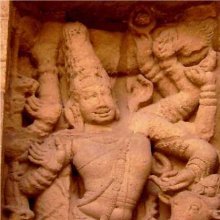Urdhvatandava, Urdhva-tandava, Ūrdhvatāṇḍava: 1 definition
Introduction:
Urdhvatandava means something in Hinduism, Sanskrit. If you want to know the exact meaning, history, etymology or English translation of this term then check out the descriptions on this page. Add your comment or reference to a book if you want to contribute to this summary article.
Images (photo gallery)
In Hinduism
Shilpashastra (iconography)
Source: Shodhganga: The significance of the mūla-beras (śilpa)Ūrdhvatāṇḍava (ऊर्ध्वताण्डव) is the name of a Mūrti depicted in the Thillai Nataraja Temple in Cidambaram (Chidambaram) which is one of the Pañcasabhā or “five halls where Śiva is said to have danced”.—Śiva is found in the posture of the completion of ūrdhva-tāṇḍava. Śiva is found with his right leg lifted straight up with his right leg near his right ear. He is found with four arms. The upper right hand is around his right leg and the upper left hand is raised up. The lower right hand is in abhaya-hasta and the lower left hand is in varada-hasta.

Shilpashastra (शिल्पशास्त्र, śilpaśāstra) represents the ancient Indian science (shastra) of creative arts (shilpa) such as sculpture, iconography and painting. Closely related to Vastushastra (architecture), they often share the same literature.
See also (Relevant definitions)
Partial matches: Urdhva, Tandava.
Starts with: Urdhvatandavamurti.
Query error!
Full-text: Urdhvatandavamurti, Nataraja.
Relevant text
Search found 8 books and stories containing Urdhvatandava, Urdhva-tandava, Ūrdhva-tāṇḍava, Ūrdhvatāṇḍava; (plurals include: Urdhvatandavas, tandavas, tāṇḍavas, Ūrdhvatāṇḍavas). You can also click to the full overview containing English textual excerpts. Below are direct links for the most relevant articles:
The Religion and Philosophy of Tevaram (Thevaram) (by M. A. Dorai Rangaswamy)
Chapter 4.3 - (b) The seven Tandava Dances of Shiva < [Volume 2 - Nampi Arurar and Mythology]
Chapter 4.3 - (a) Nataraja (the dance of Shiva) < [Volume 2 - Nampi Arurar and Mythology]
Chapter 4.3 - (c) Sculptures of Shiva and Dance < [Volume 2 - Nampi Arurar and Mythology]
Early Chola Temples (by S. R. Balasubrahmanyam)
Muktesvaram < [Chapter XIV - Conclusion]
Bronze, group 2: Age of Aditya I (a.d. 871-907) < [Chapter XI - Sculpture]
Bronze, group 1: Late Pallava and Early Chola—Age of Vijayalaya (a.d. 785-871) < [Chapter XI - Sculpture]
Later Chola Temples (by S. R. Balasubrahmanyam)
Temples in Tiruvalangadu < [Chapter II - Temples of Kulottunga I’s Time]
Temples in Chidambaram < [Chapter II - Temples of Kulottunga I’s Time]
Temples in Achyutamangalam < [Chapter XII - Temples of Kulottunga III’s Time]
The Spice Road ‘Vaṭakarai Zamīndāri’ Its Historicity and Architectural Remains1 < [Volume 74 (2013)]
Nāyaka Chefs-d’œuvre Structure and Iconography of the Śrīvilliputtūr Tēr 1 < [Volume 77 (2016)]
Pallava period (Social and Cultural History) (by S. Krishnamurthy)
Shaivism during the Pallava period < [Chapter 3 - Socio-Religious Life]
Ornamental Diagonal Band across the Body < [Chapter 4 - Material Culture of the People]
Leg Ornaments < [Chapter 4 - Material Culture of the People]
The Tamil Tyagayya: A Centenary < [October 1990 – December, 1990]
Related products
